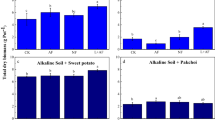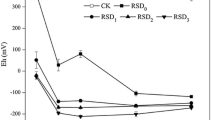Abstract
Lime-N (calcium cyanamide, CaCN2) acts as both fertilizer and pesticide. Lime-N may reduce nitrous oxide (N2O) emission from soil, although its effectiveness and the relative mechanisms are not well understood. The aim of the study was to quantify the effect of lime-N on N2O emission from the acidic soil of tea fields. The study design consisted of two treatments: conventional fertilizer (CF) (application of conventional organo-chemical fertilizer) and lime-N (LN) (application of approximately 53 % of the applied N as lime-N and the remaining as conventional organo-chemical fertilizer). Both treatments had the same amount of N, P2O5, and K2O applied to soil between plant canopies; fertilizer was incorporated into soil. We measured N2O emissions and environmental and microbial parameters of soil between plant canopies and under the canopy of tea plants, including the concentrations of dicyandiamide and cyanamide derived from lime-N. Nitrous oxide emission from soil between plant canopies was lower in the LN treatment than in the CF treatment, and soil ammonium oxidation activity and soil denitrification rate decreased after lime-N application. We applied the acetylene inhibition technique and analyzed isotopomer ratios of N2O; the results of both techniques suggested that denitrification was the major process of N2O production in the soil between plant canopies, despite relatively low water-filled pore space. Cumulative N2O emission over the 366 days of the experiment was 36.0 % lower in the LN treatment than in the CF treatment (P < 0.05). Our results suggest that lime-N application decreases N2O emission by inhibiting both nitrification and denitrification processes in the acidic soil.




Similar content being viewed by others
References
Akiyama H, Yan X, Yagi K (2006) Estimations of emission factors for fertilizer-induced direct N2O emissions from agricultural soils in Japan: summary of available data. Soil Sci Plant Nutr 52:774–787
Akiyama H, Morimoto S, Hayatsu M, Hayakawa A, Sudo S, Yagi K (2013) Nitrification, ammonia-oxidizing communities, and N2O and CH4 fluxes in an imperfectly drained agricultural field fertilized with coated urea with and without dicyandiamide. Biol Fertil Soils 49:213–223
Bååth E, Anderson T (2003) Comparison of soil fungal/bacterial ratios in a pH gradient using physiological and PLFA-based techniques. Soil Biol Biochem 35:955–963
Baggs EM, Philippot L (2010) Microbial terrestrial pathways to nitrous oxide. In: Smith K (ed) Nitrous oxide and climate change. Earthscan, London, pp 4–35
Bateman EJ, Baggs EM (2005) Contribution of nitrification and denitrification to N2O emissions from soils at different water-filled pore space. Biol Fertil Soils 41:379–388
Belser LW, Mays EL (1980) Specific inhibition of nitrite oxidation by chlorate and its use in assessing nitrification in soils and sediments. Appl Environ Microbiol 39:505–510
Ciarlo E, Conti M, Bartoloni N, Rubio G (2007) The effect of moisture on nitrous oxide emissions from soil and the N2O/(N2O + N2) ratio under laboratory conditions. Biol Fertil Soils 43:675–681
Di HJ, Cameron KC, Sherlock RR, Shen J, He J, Winefield CS (2010) Nitrous oxide emissions from grazed grassland as affected by a nitrification inhibitor, dicyandiamide, and relationships with ammonia-oxidizing bacteria and archaea. J Soil Sed 10:943–954
FAO (Food and Agriculture Organization) (2012) FAOSTAT production quantities by country. http://faostat3.fao.org/home/index.html#VISUALIZE (Accessed 18 December 2012)
Fu X, Li Y, Su W, Shen J, Xiao R, Tong C, Wu J (2012) Annual dynamics of N2O emissions from a tea field in southern subtropical China. Plant Soil Environ 58:373–378
Granli T, Bøckman OC (1994) Nitrous oxide from agriculture. Norw J Agric Sci 12:7–127
Guo J, Liu X, Zhang Y, Shen J, Han W, Zhang W, Christie P, Goulding K, Vitousek P, Zhang F (2010) Significant acidification in major Chinese croplands. Science 327:1008–1010
Haenseler CM, Moyer TR (1937) Effect of calcium cyanamide on the soil microflora with special reference to certain plant parasites. Soil Sci 43:133–151
Hayatsu M, Tago K, Saito M (2008) Various players in the nitrogen cycle: diversity and functions of the microorganisms involved in nitrification and denitrification. Soil Sci Plant Nutr 54:33–45
Hirono Y, Nonaka K (2012) Nitrous oxide emissions from green tea fields in Japan: contribution of emissions from soil between rows and soil under the canopy of tea plants. Soil Sci Plant Nutr 58:384–392
Jumadi O, Hala Y, Inubushi K (2005) Production and emission of nitrous oxide and responsible microorganisms in upland acid soil in Indonesia. Soil Sci Plant Nutr 51:693–696
Klasse HJ (1996) Calcium cyanamide, an effective tool to control clubroot: a review. Acta Hort 407:403–409
Maeda M, Kuno C, Kitamura H (2001) An annual change of nitrous oxide (N2O) flux from the tea field soil and the estimation and annual amount of N2O flux. Res Bull Aichi Agric Res Ctr 33:109–114 (in Japanese with English abstract)
Minamikawa K, Nishimura S, Sawamoto T, Nakajima Y, Yagi K (2010) Annual emissions of dissolved CO2, CH4, and N2O in the subsurface drainage from three cropping systems. Glob Change Biol 16:796–809
Mkhabela MS, Gordon R, Burton D, Madani A, Hart W (2006) Effect of lime, dicyandiamide and soil water content on ammonia and nitrous oxide emissions following application of liquid hog manure to marshland soil. Plant Soil 284:351–361
NIES (National Institute for Environmental Studies) (2012) National greenhouse gas inventory report of Japan. Ministry of the Environment, Japan
Oh K, Kato T, Zhong-Pei Li, Fa-Yun Li (2006) Environmental problems from tea cultivation in Japan and a control measure using calcium cyanamide. Pedosphere 16:770–777
Okano K, Matsuo K (1996) Seasonal changes in uptake, distribution and redistribution of 15N-nitrogen in young tea (Camellia sinensis L.) plants. Jpn J Cop Sci 65:707–713
Owa N (2010) The analysis of the influence of cyanamide, derived from lime-nitrogen, on the inhibition of nitrification. Niigata Agronomy 46:39–43 (in Japanese)
Ravishankara AR, Daniel JS, Portman RW (2009) Nitrous oxide (N2O): the dominant ozone-depleting substance emitted in the 21st century. Science 326:123–125
Ruser R, Flessa H, Russow R, Schmidt G, Buegger F, Munch J (2006) Emission of N2O, N2 and CO2 from soil fertilized with nitrate: effect of comparison, soil moisture and rewetting. Soil Biol Biochem 38:263–274
Shoun H, Kim D, Uchiyama H, Sugiyama J (1992) Denitrification by fungi. FEMS Microbiol Lett 94:277–282
Shoun H, Fushinobu S, Jiang L, Kim S, Wakagi T (2012) Fungal denitrification and nitric oxide reductase cytochrome P450nor. Phil Trans R Soc B 367:1186–1194
Smith K, Thomson P, Clayton H, McTaggart I, Conen F (1998) Effects of temperature, water content and nitrogen fertilization on emission of nitrous oxide by soils. Atmos Environ 32:3301–3309
Solomon S, Qin D, Manning M, Marquis M, Averyt K, Tignor MMB, Miller HL Jr, Chen Z (2007) Climate change 2007: the physical science basis: contribution of Working Group I to the Fourth Assessment Report of the Intergovernmental Panel on Climate Change. Cambridge University Press, Cambridge
Tachibana N, Yoshikawa S, Ikeda K (1995) Behavior of inorganic nitrogen in tea field soils heavily applied with nitrogen and changes in amino acid content of the first crop accompanying the reduction of nitrogen. Jpn J Crop Sci 64:523–528 (in Japanese with English abstract)
Thomson A, Giannopoulos G, Pretty J, Baggs E, Richardson D (2012) Biological sources and sinks of nitrous oxide and strategies to mitigate emissions. Phil Trans R Soc B 367:1157–1168
Tokuda S, Hayatsu M (2000) Nitrous oxide production from strongly acid tea field soils. Soil Sci Plant Nutr 46:835–844
Tokuda S, Hayatsu M (2001) Nitrous oxide emission potential of 21 acidic tea field soils in Japan. Soil Sci Plant Nutr 47:637–642
Tokuda S, Hayatsu M (2004) Nitrous oxide flux from a tea field amended with a large amount of nitrogen fertilizer and soil environmental factors controlling the flux. Soil Sci Plant Nutr 50:365–374
Toyoda S, Mutobe H, Yamagishi H, Yoshida N, Tanji Y (2005) Fraction of N2O isotopomers during production by denitrifier. Soil Biol Biochem 37:1535–1545
Toyoda S, Yano M, Nishimura S, Akiyama H, Hayakawa A, Koba K, Sudo S, Yagi K, Makabe A, Tobari Y, Ogawa N, Ohkouchi N, Yamada K, Yoshida N (2011) Characterization and production and consumption processes of N2O emitted from temperate agricultural soils determined via isotopomer ratio analysis. Glob Biochem Cycles 25, GB2008. doi:10.1029/2009GB003769
Yamamoto A, Akiyama H, Naokawa T, Yagi K (2012) Effect of lime-nitrogen application on N2O emission from an Andosol vegetable field. Soil Sci Plant Nutr 58:245–254
Yamamoto A, Akiyama H, Naokawa T, Yagi K (2013) Lime-nitrogen application reduces N2O emission from a vegetable field with imperfectly-drained sandy clay-loam soil. Soil Sci Plant Nutr doi:10.1080/00380768.2013.772496
Yamulki S, Harrison R, Goulding K, Webster C (1997) N2O, NO and NO2 fluxes from a grassland: effect of soil pH. Soil Biol Biochem 29:1199–1208
Yoshinari T, Knowles R (1976) Acetylene inhibition of nitrous oxide reduction by denitrifying bacteria. Biochem Biophys Res Commun 69:705–710
Acknowledgments
We are grateful to Dr. Shigeto Sudo, Dr. Syuntaro Hiradate, and Dr. Jun Tabata (National Institute for Agro-Environmental Sciences, Japan) for assistance with the gas chromatography and liquid chromatography, and to the staff of the Green Tea Laboratory of Saitama Prefectural Agriculture and Forestry Research Center for assistance with the fieldwork. We thank Dr. Sakae Toyoda (Tokyo Institute of Technology) for providing the standard gas of isotopomer ratios of N2O. This study was financially supported in part by Denki Kagaku Kogyo Kabushiki Kaisha.
Author information
Authors and Affiliations
Corresponding author
Electronic supplementary material
Below is the link to the electronic supplementary material.
Fig. S1
Description of the experimental design. (PDF 162 kb)
Fig. S2
The relationship between soil temperature at 5 cm depth and N2O emission from soil between the plant canopies (B) and under plant canopies (C) in the (a) organo-chemical fertilizer (CF) and (b) lime-N (LN) treatments. Error bars represent the standard deviation of the measurements from replicate plots (n = 4). (PDF 43 kb)
Supplementary Table 1 (Table S1)
(DOC 30 kb)
Rights and permissions
About this article
Cite this article
Yamamoto, A., Akiyama, H., Naokawa, T. et al. Lime-nitrogen application affects nitrification, denitrification, and N2O emission in an acidic tea soil. Biol Fertil Soils 50, 53–62 (2014). https://doi.org/10.1007/s00374-013-0830-6
Received:
Revised:
Accepted:
Published:
Issue Date:
DOI: https://doi.org/10.1007/s00374-013-0830-6




